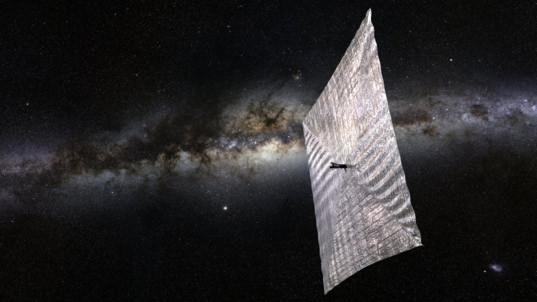In the coming decades, multiple space agencies plan to return astronauts to the Moon (or to send them there for the first time) and mount the first crewed missions to Mars. Between that and the explosive growth we are seeing in Low Earth Orbit (LEO), there is no doubt that we live in an era of renewed space exploration. It’s therefore understandable that old and new concepts for interstellar travel are also being considered these days.
Right now, a considerable focus is on light sails that generate their own propulsion by radiation pressure or are accelerated by lasers. These concepts present all kinds of technical and engineering challenges. Luckily, Coryn Bailer-Jones of the Max Planck Institute for Astronomy (MPIA) recently conducted a study where he argues for a “Sun Diver” light sail that will pick up all the speed it needs by diving close to the Sun.
The study, titled “The Sun Diver: Combining solar sails with the Oberth effect,” recently appeared in the American Journal of Physics. As Bailer-Jones noted, one of the greatest appeals of solar sails and light sails is the fact that they free the spacecraft from having to carry its own propellant. This ensures less mass, which will ultimately allow the spacecraft to accelerate to greater velocities.
This is a consequence of the Tsiolkovsky’s famous Rocket Equation, which describes how a spacecraft will apply acceleration by expelling part of its mass (propellant) as thrust. A consequence of this equation is that the amount of propellant a rocket must carry to increase its velocity (delta-v) grows exponentially as delta-v increases, mainly because most of the propellant is used to accelerate the unused propellant.
To date, a number of concepts have been developed and tested as a means of exploring the Solar System, including the Planetary Society’s LightSail and Lightsail 2, and JAXA’s IKAROS satellite. In addition, various organizations are exploring the idea of light sails accelerated by laser arrays as a means for interstellar travel – such as Breakthrough Starshot, Project Dragonfly, and NASA’s Starlight.
In both cases, a light sail offers advantages. As Bailer-Jones told Universe Today via email:
“For solar system exploration, solar sails therefore allow you to perform a lot of different manoeuvres, or to get into orbits that would otherwise require a lot of propellant. For interstellar travel we would use a solar sail to dive as close to the Sun as possible to therefore gain the maximum acceleration from the Sun.

This method is advantageous since conventional solar sails rely on radiation pressure, which has some drawbacks. According to Bailer-Jones, these include total dependence on the Sun for a modest amount of acceleration. “Specifically, the maximum acceleration you get from the Sun with a solar sail drops with the square of the distance from the Sun,” he said. “So they are not much use when you are very far from the Sun.”
Since the amount of radiation pressure (and resulting delta-v) is small in these cases, the light sail would either need to be extremely light or extremely large. One way around this issue is to rely on powerful directed-energy (laser) arrays to accelerate the sail. This is precisely what the Starshot, Dragonfly, and Starlight concepts call for, but such an array would be very expensive to build and operate.
Another possible solution, according to Bailer-Jones, is to create a light sail that can take advantage of the Oberth Effect. As he explained:
“The principle of the Oberth effect is to apply your boost when you are moving fastest relative to the body you are orbiting, which is the Sun in the case of the Sundiver. The closer you are to the Sun in your orbit, the faster you will be. So to take advantage of the Oberth effect you need to get as close to the Sun as possible.“

For this process, a spacecraft with a sail stowed inside and a small amount of propellant would assume a circular orbit around the Sun. The spacecraft could then do one of three things. First, it could use all of its propellant to execute a retrograde boost (which would decrease its orbital velocity) and drop as close as possible to the Sun before deploying its sail.
Second, it could forego the dive entirely and apply a full prograde boost (increasing its orbital velocity) as the sails are deployed. Third, it could execute a combination of the two. He also considered a scenario in which the sails would be opened on the initial circular orbit, and the full propellant boost applied at the end.
After considering all of these scenarios, Bailer-Jones concluded that the highest velocity would be achieved by having the spacecraft execute a full retrograde boost to dive as close to the Sun as possible, then opening its sail once it reaches perihelion. According to his calculations, a sail could reach a terminal velocity of around 350 km/s this way – which works out to 1.26 million km/h (~783,00 mph).
This is substantially faster than what chemical rockets are capable of achieving. Currently, the record for the fastest spacecraft is held by the Parker Solar Probe, which achieved a maximum velocity of about 246,960 km/h (153,454 mph). Still, at a terminal velocity of 1.26 million km/h, it would still take a light sail about 2,865 years to reach Proxima Centauri.

As Bailer-Jones indicated, this is due to the limits of materials science, which imposes limitations on how close a spacecraft can get to the Sun. “[I]f your spacecraft could withstand approaching closer to the Sun than the dive you could achieve with the available delta-v, then you could tilt the sail to spiral in as close to the Sun as possible and then apply the delta-v as a boost,” he said.
In addition, his study focuses on what can be achieved with a single transfer orbit. As an extension, he claims that an optimal combination of the three impulse methods he identified during two transfer orbits could also lead to greater velocities. But even so, there are many mission profiles that a Sun Diver could fulfill, especially closer to home:
“The utility of the Oberth effect may be limited in practice, however, as for many missions you are not only interested in speed. You also want to control the direction you travel in, and when you get to certain destinations, so fixing these may not be compatible with the maximum possible boost from the Oberth effect.”
As for interstellar missions, that will have to wait upon advances in materials science, regardless of whether or not a “Sun Diver” or a directed-energy propulsion concept is involved. Luckily, such advances (and many more besides) are anticipated in the coming years, and the implications for space exploration will certainly be profound!
Further Reading: arXiv

